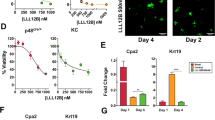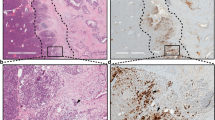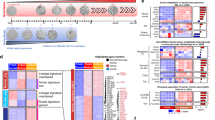Abstract
Pancreatic ductal adenocarcinoma (PDAC) is one of the most lethal cancers owing to a number of characteristics including difficulty in establishing early diagnosis and the absence of effective therapeutic regimens. A large number of genetic alterations have been ascribed to PDAC with mutations in the KRAS2 proto-oncogene thought to be an early event in the progression of disease. Recent lineage-tracing studies have shown that acinar cells expressing mutant KrasG12D are induced to transdifferentiate, generating duct-like cells through a process known as acinar-ductal metaplasia (ADM). ADM lesions then convert to precancerous pancreatic intraepithelial neoplasia (PanIN) that progresses to PDAC over time. Thus, understanding the earliest events involved in ADM/PanIN formation would provide much needed information on the molecular pathways that are instrumental in initiating this disease. As studying the transition of acinar cells to metaplastic ductal cells in vivo is complicated by analysis of the entire organ, an in vitro three dimensional (3D) culture system was used to model ADM outside the animal. KrasG12D-expressing acinar cells rapidly underwent ADM in 3D culture, forming ductal cysts that silenced acinar genes and activated duct genes, characteristics associated with in vivo ADM/PanIN lesions. Analysis of downstream KRAS signaling events established a critical importance for the Raf/MEK/ERK pathway in ADM induction. In addition, forced expression of the acinar-restricted transcription factor Mist1, which is critical to acinar cell organization, significantly attenuated KrasG12D-induced ADM/PanIN formation. These results suggest that maintaining MIST1 activity in KrasG12D-expressing acinar cells can partially mitigate the transformation activity of oncogenic KRAS. Future therapeutics that target both the MAPK pathway and Mist1 transcriptional networks may show promising efficacy in combating this deadly disease.
This is a preview of subscription content, access via your institution
Access options
Subscribe to this journal
Receive 50 print issues and online access
$259.00 per year
only $5.18 per issue
Buy this article
- Purchase on Springer Link
- Instant access to full article PDF
Prices may be subject to local taxes which are calculated during checkout






Similar content being viewed by others
References
Jemal A, Siegel R, Xu J, Ward E . Cancer statistics, 2010. CA Cancer J Clin 2010; 60: 277–300.
Maitra A, Fukushima N, Takaori K, Hruban RH . Precursors to invasive pancreatic cancer. Adv Anat Pathol 2005; 12: 81–91.
Hruban RH, Adsay NV, Albores-Saavedra J, Compton C, Garrett ES, Goodman SN et al. Pancreatic intraepithelial neoplasia—a new nomenclature and classification system for pancreatic duct lesions. Am J Surg Pathol 2001; 25: 579–586.
Shi G, Zhu L, Sun Y, Bettencourt R, Damsz B, Hruban RH et al. Loss of the acinar-restricted transcription factor Mist1 accelerates Kras-induced pancreatic intraepithelial neoplasia. Gastroenterology 2009; 136: 1368–1378.
Guerra C, Mijimolle N, Dhawahir A, Dubus P, Barradas M, Serrano M et al. Tumor induction by an endogenous K-ras oncogene is highly dependent on cellular context. Cancer Cell 2003; 4: 111–120.
Hingorani SR, Wang L, Multani AS, Combs C, Deramaudt TB, Hruban RH et al. Trp53R172H and KrasG12D cooperate to promote chromosomal instability and widely metastatic pancreatic ductal adenocarcinoma in mice. Cancer Cell 2005; 7: 469–483.
Bardeesy N, Aguirre AJ, Chu GC, Cheng K-h, Lopez LV, Hezel AF et al. Both p16Ink4a and the p19Arf-p53 pathway constrain progression of pancreatic adenocarcinoma in the mouse. Proc Natl Acad Sci USA 2006; 103: 5947–5952.
Bardeesy N, Cheng K-h, Berger JH, Chu GC, Pahler J, Olson P et al. Smad4 is dispensable for normal pancreas development yet critical in progression and tumor biology of pancreas cancer. Genes Dev 2006; 20: 3130–3146.
Siveke JT, Einwachter H, Sipos B, Lubeseder-Martellato C, Kloppel G, Schmid RM . Concomitant pancreatic activation of Kras(G12D) and Tgfa results in cystic papillary neoplasms reminiscent of human IPMN. Cancer Cell 2007; 12: 266–279.
De La OJ-P, Emerson LL, Goodman JL, Froebe SC, Illum BE, Curtis AB et al. Notch and Kras reprogram pancreatic acinar cells to ductal intraepithelial neoplasia. Proc Natl Acad Sci USA 2008; 105: 18907–18912.
Brembeck FH, Schreiber FS, Deramaudt TB, Craig L, Rhoades B, Swain G et al. The mutant K-ras oncogene causes pancreatic periductal lymphocytic infiltration and gastric mucous neck cell hyperplasia in transgenic mice. Cancer Res 2003; 63: 2005–2009.
Ray KC, Bell KM, Yan J, Gu G, Chung CH, Washington MK et al. Epithelial tissues have varying degrees of susceptibility to Kras(G12D)-initiated tumorigenesis in a mouse model. PLoS One 2011; 6: e16786.
Habbe N, Shi G, Meguid RA, Fendrich V, Esni F, Chen H et al. Spontaneous induction of murine pancreatic intraepithelial neoplasia (mPanIN) by acinar cell targeting of oncogenic Kras in adult mice. Proc Natl Acad Sci USA 2008; 105: 18913–18918.
Friedlander SYG, Chu GC, Snyder EL, Girnius N, Dibelius G, Crowley D et al. Context-dependent transformation of adult pancreatic cells by oncogenic K-Ras. Cancer Cell 2009; 16: 379–389.
Guerra C, Schuhmacher AJ, Canamero M, Grippo PJ, Verdaguer L, Perez-Gallego L et al. Chronic pancreatitis is essential for induction of pancreatic ductal adenocarcinoma by K-Ras oncogenes in adult mice. Cancer Cell 2007; 11: 291–302.
Morris JP, Cano DA, Sekine S, Wang SC, Hebrok M . [beta]-catenin blocks Kras-dependent reprogramming of acini into pancreatic cancer precursor lesions in mice. J Clin Invest 2010; 120: 508–520.
Zhu L, Shi G, Schmidt CM, Hruban RH, Konieczny SF . Acinar cells contribute to the molecular heterogeneity of pancreatic intraepithelial neoplasia. Am J Pathol 2007; 171: 263–273.
Brune K, Abe T, Canto M, O'Malley L, Klein AP, Maitra A et al. Multifocal neoplastic precursor lesions associated with lobular atrophy of the pancreas in patients having a strong family history of pancreatic cancer. Am J Surg Pathol 2006; 30: 1067–1076.
Means AL, Meszoely IM, Suzuki K, Miyamoto Y, Rustgi AK, Coffey RJ et al. Pancreatic epithelial plasticity mediated by acinar cell transdifferentiation and generation of nestin-positive intermediates. Development 2005; 132: 3767–3776.
Schreiber FS, Deramaudt TB, Brunner TB, Boretti MI, Gooch KJ, Stoffers DA et al. Successful growth and characterization of mouse pancreatic ductal cells: functional properties of the Ki-RAS(G12V) oncogene. Gastroenterology 2004; 127: 250–260.
Heid I, Lubeseder-Martellato C, Sipos B, Mazur PK, Lesina M, Schmid RM et al. Early requirement of rac1 in a mouse model of pancreatic cancer. Gastroenterology 2011; 141: 719–730 e7.
Pin CL, Rukstalis JM, Johnson C, Konieczny SF . The bHLH transcription factor Mist1 is required to maintain exocrine pancreas cell organization and acinar cell identity. J Cell Biol 2001; 155: 519–530.
Carriere C, Seeley ES, Goetze T, Longnecker DS, Korc M . The Nestin progenitor lineage is the compartment of origin for pancreatic intraepithelial neoplasia. Proc Natl Acad Sci USA 2007; 104: 4437–4442.
Hezel AF, Kimmelman AC, Stanger BZ, Bardeesy N, DePinho RA . Genetics and biology of pancreatic ductal adenocarcinoma. Genes Dev 2006; 20: 1218–1249.
Downward J . Targeting RAS signalling pathways in cancer therapy. Nat Rev Cancer 2003; 3: 11–22.
Ramsey VG, Doherty JM, Chen CC, Stappenbeck TS, Konieczny SF, Mills JC . The maturation of mucus-secreting gastric epithelial progenitors into digestive-enzyme secreting zymogenic cells requires Mist1. Development 2007; 134: 211–222.
Tuveson DA, Zhu L, Gopinathan A, Willis NA, Kachatrian L, Grochow R et al. Mist1-KrasG12D knock-in mice develop mixed differentiation metastatic exocrine pancreatic carcinoma and hepatocellular carcinoma. Cancer Res 2006; 66: 242–247.
Sakai K, Miyazaki J . A transgenic mouse line that retains Cre recombinase activity in mature oocytes irrespective of the cre transgene transmission. Biochem Biophys Res Commun 1997; 237: 318–324.
Shi C, Hong SM, Lim P, Kamiyama H, Khan M, RA Anders et al. KRAS2 mutations in human pancreatic acinar-ductal metaplastic lesions are limited to those with PanIN: implications for the human pancreatic cancer cell of origin. Mol Cancer Res 2009; 7: 230–236.
Sandgren EP, Luetteke NC, Palmiter RD, Brinster RL, Lee DC . Overexpression of TGF alpha in transgenic mice: induction of epithelial hyperplasia, pancreatic metaplasia, and carcinoma of the breast. Cell 1990; 61: 1121–1135.
Wagner M, Luhrs H, Kloppel G, Adler G, Schmid RM . Malignant transformation of duct-like cells originating from acini in transforming growth factor transgenic mice. Gastroenterology 1998; 115: 1254–1262.
Detlefsen S, Sipos B, Feyerabend B, Kloppel G . Pancreatic fibrosis associated with age and ductal papillary hyperplasia. Virchows Archy 2005; 447: 800–805.
Strobel O, Dor Y, Alsina J, Stirman A, Lauwers G, Trainor A et al. In vivo lineage tracing defines the role of acinar-to-ductal transdifferentiation in inflammatory ductal metaplasia. Gastroenterology 2007; 133: 1999–2009.
Jensen JN, Cameron E, Garay MV, Starkey TW, Gianani R, Jensen J . Recapitulation of elements of embryonic development in adult mouse pancreatic regeneration. Gastroenterology 2005; 128: 728–741.
Carriere C, Young AL, Gunn JR, Longnecker DS, Korc M . Acute pancreatitis markedly accelerates pancreatic cancer progression in mice expressing oncogenic Kras. Biochemical and biophysical research communications 2009; 382: 561–565.
Malka D, Hammel P, Maire F, Rufat P, Madeira I, Pessione F et al. Risk of pancreatic adenocarcinoma in chronic pancreatitis. Gut 2002; 51: 849–852.
Calhoun ES, Jones JB, Ashfaq R, Adsay V, Baker SJ, Valentine V et al. BRAF and FBXW7 (CDC4, FBW7, AGO, SEL10) mutations in distinct subsets of pancreatic cancer: potential therapeutic targets. AmJ Pathol 2003; 163: 1255–1260.
Houbracken I, de Waele E, Lardon J, Ling Z, Heimberg H, Rooman I et al. Lineage tracing evidence for transdifferentiation of acinar to duct cells and plasticity of human pancreas. Gastroenterology 2011; 141: 731–741 e4.
Lambert JM, Lambert QT, Reuther GW, Malliri A, Siderovski DP, Sondek J et al. Tiam1 mediates Ras activation of Rac by a PI(3)K-independent mechanism. Nat Cell Biol 2002; 4: 621–625.
De Corte V, Bruyneel E, Boucherie C, Mareel M, Vandekerckhove J, Gettemans J . Gelsolin-induced epithelial cell invasion is dependent on Ras-Rac signaling. EMBO J. 2002; 21: 6781–6790.
Malliri A, van der Kammen RA, Clark K, van der Valk M, Michiels F, Collard JG . Mice deficient in the Rac activator Tiam1 are resistant to Ras-induced skin tumours. Nature 2002; 417: 867–871.
Kowalik AS, Johnson CL, Chadi SA, Weston JY, Fazio EN, Pin CL . Mice lacking the transcription factor Mist1 exhibit an altered stress response and increased sensitivity to caerulein-induced pancreatitis. Am J Physiol Gastrointest Liver Physiol 2007; 292: G1123–G1132.
Carriere C, Young AL, Gunn JR, Longnecker DS, Korc M . Acute pancreatitis accelerates initiation and progression to pancreatic cancer in mice expressing oncogenic kras in the nestin cell lineage. PLoS One 2011; 6: e27725.
Rovira M, Delaspre F, Massumi M, Serra SA, Valverde MA, Lloreta J et al. Murine embryonic stem cell-derived pancreatic acinar cells recapitulate features of early pancreatic differentiation. Gastroenterology 2008; 135: 1301–1310 10 e1–5.
Hingorani SR, Petricoin EF, Maitra A, Rajapakse V, King C, Jacobetz MA et al. Preinvasive and invasive ductal pancreatic cancer and its early detection in the mouse. Cancer Cell 2003; 4: 437–450.
Zhu L, Tran T, Rukstalis JM, Sun P, Damsz B, Konieczny SF . Inhibition of Mist1 homodimer formation induces pancreatic acinar-to-ductal metaplasia. Mol Cell Biol 2004; 24: 2673–2681.
Araki K, Araki M, Miyazaki J, Vassalli P . Site-specific recombination of a transgene in fertilized eggs by transient expression of Cre recombinase. Proc Natl Acad Sci USA 1995; 92: 160–164.
Acknowledgements
We thank Judy Hallett of the Purdue Center for Cancer Research Transgenic Mouse Core Facility for generating the transgenic mouse strains used in this study and David Hess and Anju Karki for critical reading of the manuscript. This work was supported by grants to SFK (NIH CA124586, NIH DK55489 and the Phi Beta Psi Sorority for Cancer Research) and to DD (CTSI Predoctoral Fellowship).
Author contributions: GS, DD, CQ, DB and DM designed and performed experiments; SFK designed and analyzed experiments and GS and SFK wrote the manuscript.
Author information
Authors and Affiliations
Corresponding author
Ethics declarations
Competing interests
The authors declare no conflict of interest.
Additional information
Supplementary Information accompanies the paper on the Oncogene website
Supplementary information
Rights and permissions
About this article
Cite this article
Shi, G., DiRenzo, D., Qu, C. et al. Maintenance of acinar cell organization is critical to preventing Kras-induced acinar-ductal metaplasia. Oncogene 32, 1950–1958 (2013). https://doi.org/10.1038/onc.2012.210
Received:
Revised:
Accepted:
Published:
Issue Date:
DOI: https://doi.org/10.1038/onc.2012.210
Keywords
This article is cited by
-
Deciphering cellular plasticity in pancreatic cancer for effective treatments
Cancer and Metastasis Reviews (2024)
-
Senescence program and its reprogramming in pancreatic premalignancy
Cell Death & Disease (2023)
-
The role of epithelial-mesenchymal transition and autophagy in pancreatic ductal adenocarcinoma invasion
Cell Death & Disease (2023)
-
Newly identified form of phenotypic plasticity of cancer: immunogenic mimicry
Cancer and Metastasis Reviews (2023)
-
Molecular signaling in pancreatic ductal metaplasia: emerging biomarkers for detection and intervention of early pancreatic cancer
Cellular Oncology (2022)



